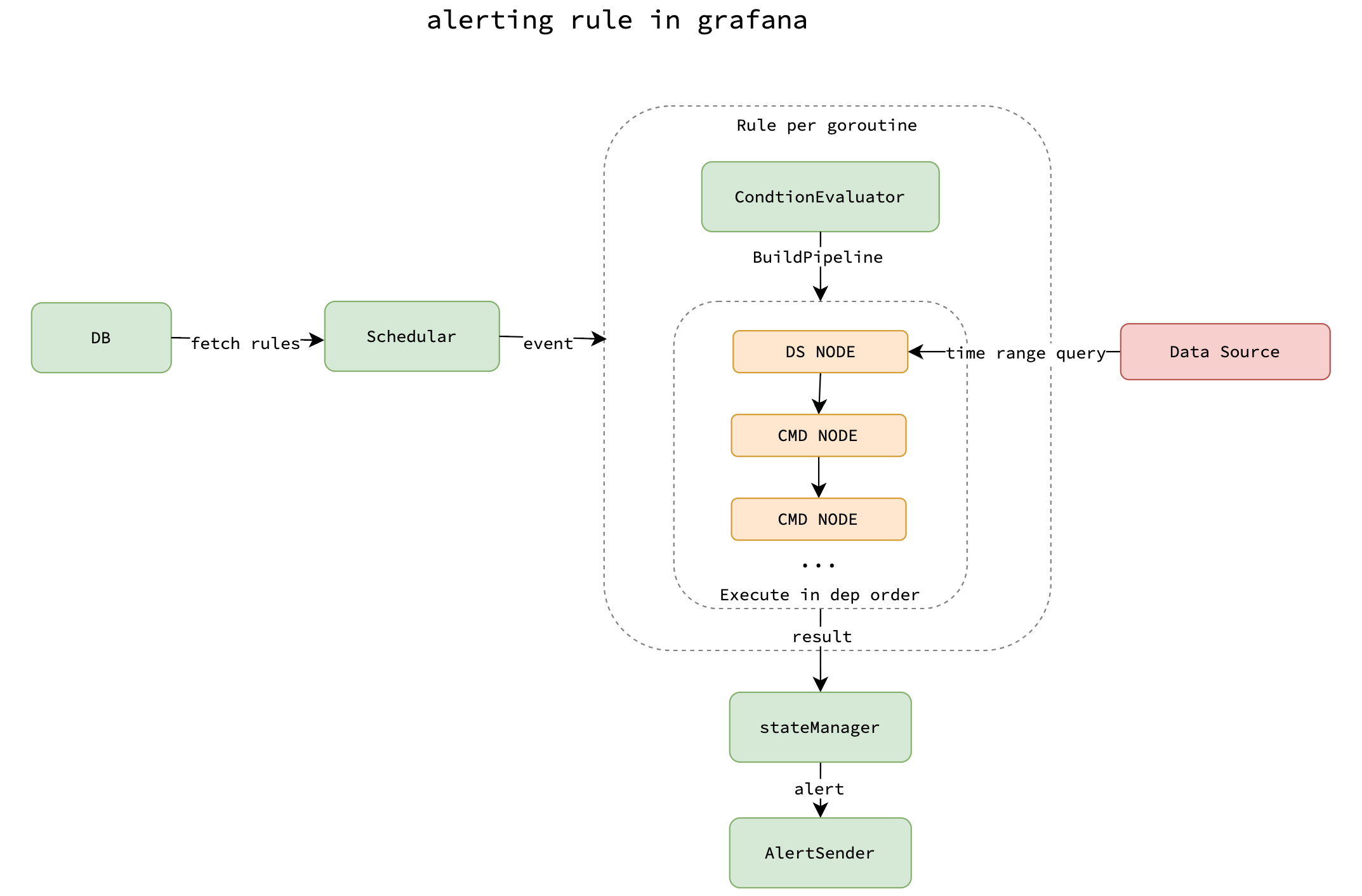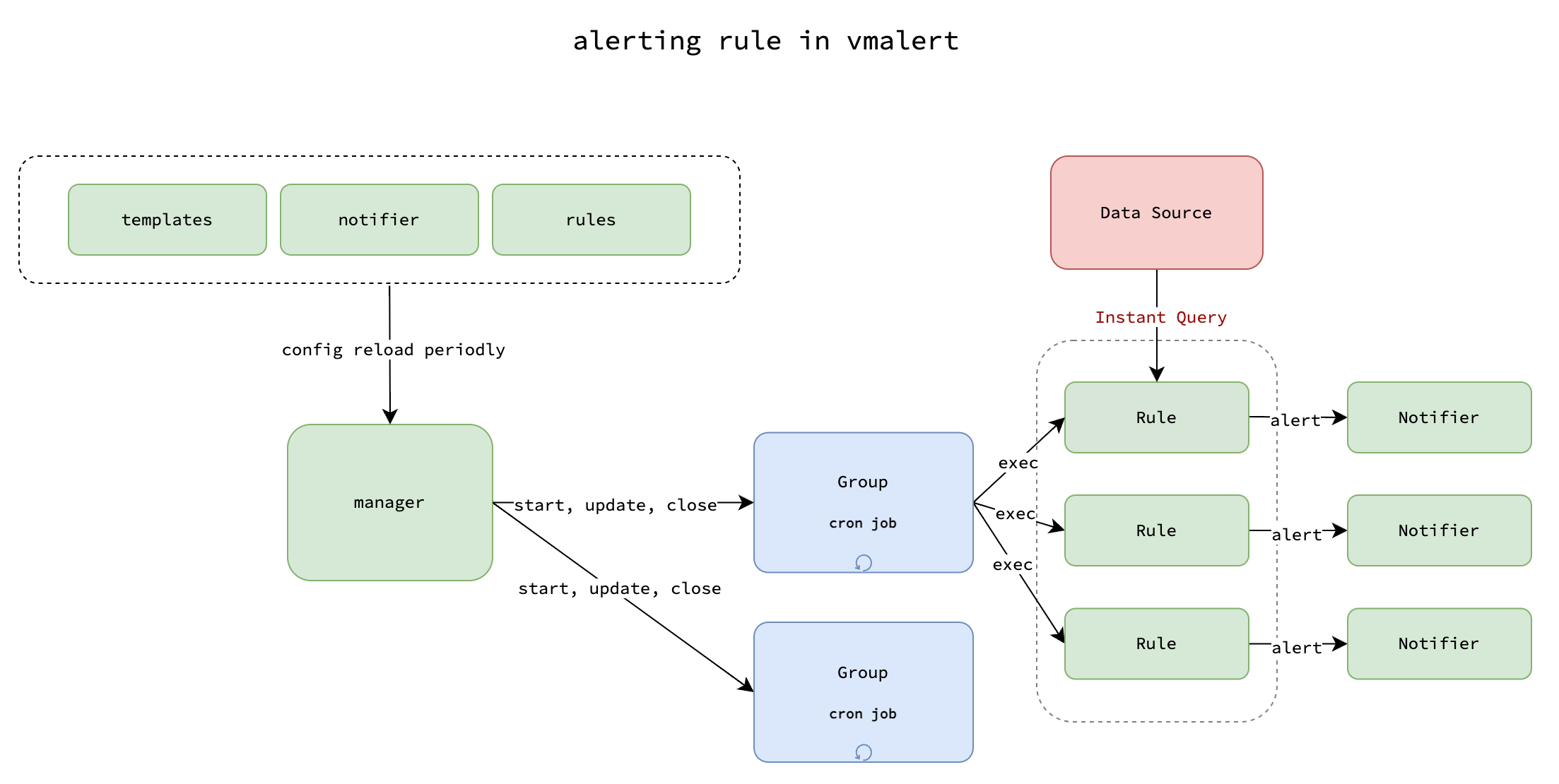alerting rule: grafana vs vmalert
Let’s try to understand how alerting rule is implemented in two open source projects: grafana and vmalert.
Version⌗
use the latest version of the according source code:
Flow⌗
grafana⌗

- Scheduler -> fetch alerting rules -> start goroutine for each alerting rule
pkg/services/ngalert/schedule/schedule.go:280
- Scheduler -> send evaluation event(when internal elapsed) -> goroutine -> evaluation
pkg/services/ngalert/schedule/alert_rule.go:242
- Schedduler -> stop the goroutine (alerting rule delted) according to the heartbeat
pkg/services/ngalert/schedule/alert_rule.go:355
vmalert⌗

- configReload (cron job by configCheckInterval) -> loading alerting rule files ->
[]config.Group []config.Group-> diff -> manager -> start the newrule.Groupand delete the oldrule.Group- start
rule.Groupper goroutine -> executor -> execConcurrently ([]rule.Rule) -> rule.exec() per goroutine
Evaluation⌗
grafana⌗
code entrance:
pkg/services/ngalert/schedule/alert_rule.go:327
evalCh -> event -> alertRule -> evaluate:
- eval.EvaluatorFactory -> create -> ConditionEvaluator (
BuildPipeline -> buildDependencyGraph -> buildExecutionOrder -> []Node) - ConditionEvaluator -> Evaluate
- expressionExecutor -> ExecutePipeline (DataPipeline []Node)
- DataPipeline -> excute -> for loop []Node -> backend.QueryDataResponse
- backend.QueryDataResponse -> EvaluateAlert -> Results
- expressionExecutor -> ExecutePipeline (DataPipeline []Node)
- Results -> stateManager.ProcessEvalResults
vmalert⌗
code entrance:
app/vmalert/rule/group.go:311
rule.Group -> exec(rule.Rule) concurrently:
- executor instant query (for now) -> response (label set of Metric that needs alerting)
- response -> update AlertingRule.alerts
- alerts -> executor.Notifier
// Querier interface wraps Query and QueryRange methods
type Querier interface {
// Query is used for the rule evaluation
Query(ctx context.Context, query string, ts time.Time) (Result, *http.Request, error)
// QueryRange is used for rule replay
QueryRange(ctx context.Context, query string, from, to time.Time) (Result, error)
}
Data Structure⌗
grafana⌗
alert rule
// pkg/services/ngalert/models/alert_rule.go:247
// AlertRule is the model for alert rules in unified alerting.
type AlertRule struct {
ID int64
OrgID int64
Title string
Condition string
Data []AlertQuery
Updated time.Time
IntervalSeconds int64
Version int64
UID string
NamespaceUID string
DashboardUID *string
PanelID *int64
RuleGroup string
RuleGroupIndex int
Record *Record
NoDataState NoDataState
ExecErrState ExecutionErrorState
// ideally this field should have been apimodels.ApiDuration
// but this is currently not possible because of circular dependencies
For time.Duration
Annotations map[string]string
Labels map[string]string
IsPaused bool
NotificationSettings []NotificationSettings
Metadata AlertRuleMetadata
}
// AlertQuery represents a single query associated with an alert definition.
type AlertQuery struct {
// RefID is the unique identifier of the query, set by the frontend call.
RefID string `json:"refId"`
// QueryType is an optional identifier for the type of query.
// It can be used to distinguish different types of queries.
QueryType string `json:"queryType"`
// RelativeTimeRange is the relative Start and End of the query as sent by the frontend.
RelativeTimeRange RelativeTimeRange `json:"relativeTimeRange"`
// Grafana data source unique identifier; it should be '__expr__' for a Server Side Expression operation.
DatasourceUID string `json:"datasourceUid"`
// JSON is the raw JSON query and includes the above properties as well as custom properties.
Model json.RawMessage `json:"model"`
modelProps map[string]any
}
Node
// pkg/expr/graph.go
const (
// TypeCMDNode is a NodeType for expression commands.
TypeCMDNode NodeType = iota
// TypeDatasourceNode is a NodeType for datasource queries.
TypeDatasourceNode
// TypeMLNode is a NodeType for Machine Learning queries.
TypeMLNode
)
// pkg/expr/nodes.go
const (
// TypeUnknown is the CMDType for an unrecognized expression type.
TypeUnknown CommandType = iota
// TypeMath is the CMDType for a math expression.
TypeMath
// TypeReduce is the CMDType for a reduction expression.
TypeReduce
// TypeResample is the CMDType for a resampling expression.
TypeResample
// TypeClassicConditions is the CMDType for the classic condition operation.
TypeClassicConditions
// TypeThreshold is the CMDType for checking if a threshold has been crossed
TypeThreshold
// TypeSQL is the CMDType for running SQL expressions
TypeSQL
)
vmalert⌗
// app/vmalert/rule/alerting.go:24
// AlertingRule is basic alert entity
type AlertingRule struct {
Type config.Type
RuleID uint64
Name string
Expr string
For time.Duration
KeepFiringFor time.Duration
Labels map[string]string
Annotations map[string]string
GroupID uint64
GroupName string
File string
EvalInterval time.Duration
Debug bool
q datasource.Querier
alertsMu sync.RWMutex
// stores list of active alerts
alerts map[uint64]*notifier.Alert
// state stores recent state changes
// during evaluations
state *ruleState
metrics *alertingRuleMetrics
}
// app/vmalert/rule/group.go:40
// Group is an entity for grouping rules
type Group struct {
mu sync.RWMutex
Name string
File string
Rules []Rule
Type config.Type
Interval time.Duration
EvalOffset *time.Duration
// EvalDelay will adjust timestamp for rule evaluation requests to compensate intentional query delay from datasource.
// see https://github.com/VictoriaMetrics/VictoriaMetrics/issues/5155
EvalDelay *time.Duration
Limit int
Concurrency int
Checksum string
LastEvaluation time.Time
Labels map[string]string
Params url.Values
Headers map[string]string
NotifierHeaders map[string]string
doneCh chan struct{}
finishedCh chan struct{}
// channel accepts new Group obj
// which supposed to update current group
updateCh chan *Group
// evalCancel stores the cancel fn for interrupting
// rules evaluation. Used on groups update() and close().
evalCancel context.CancelFunc
metrics *groupMetrics
// evalAlignment will make the timestamp of group query
// requests be aligned with interval
evalAlignment *bool
}
Read other posts